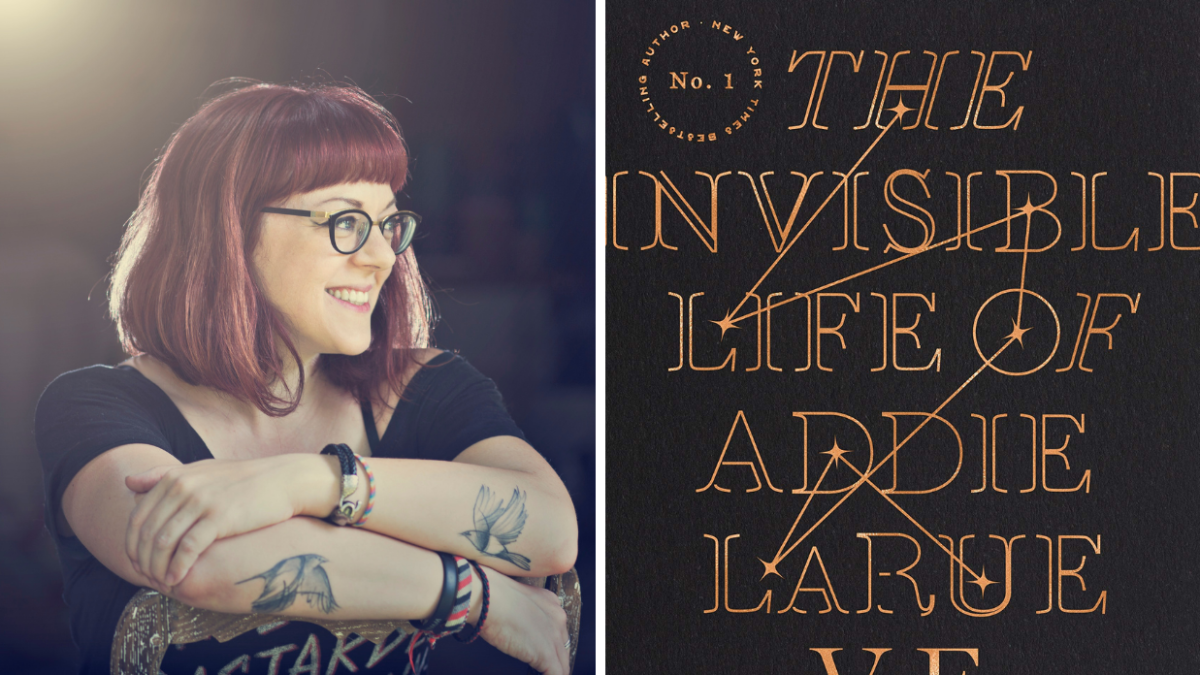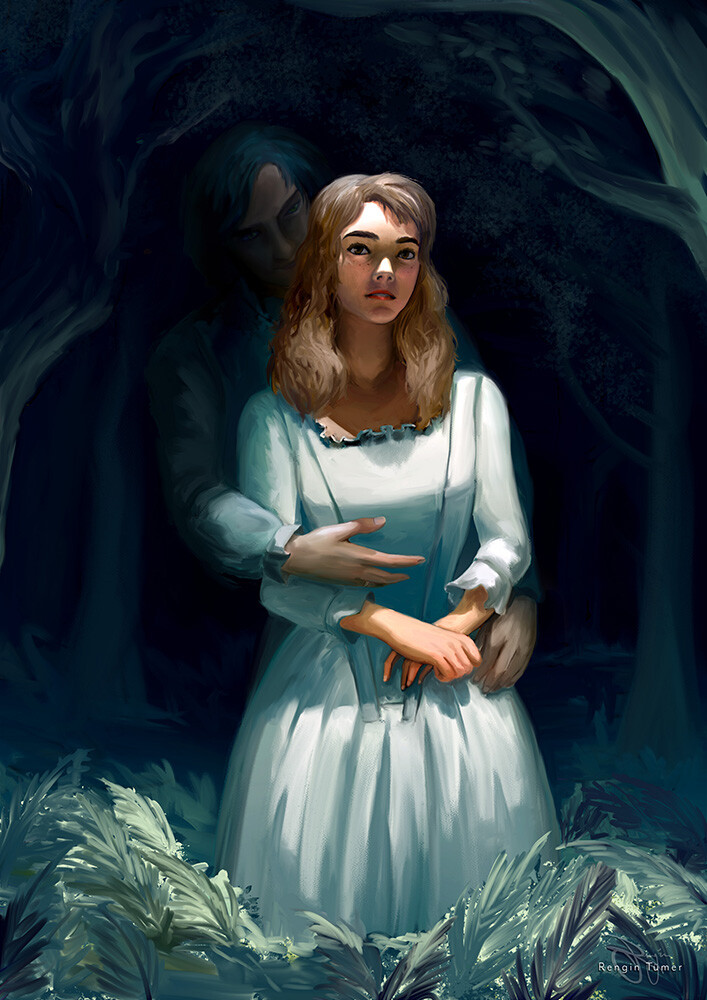The Invisible Life of Addie LaRue: A Tale of Immortality A Decade in the Making
In V.E. Schwab's The Invisible Life of Addie LaRue, a girl makes a deal with the devil to live forever, and is cursed to be forgotten by everyone she meets.

This article is sponsored by 
The first time I ever interviewed V.E. Schwab, she told me about The Invisible Life of Addie LaRue. It was July 2018 and we were sitting in the lobby of the Hilton Bayfront Hotel during San Diego Comic Con. Schwab was in the midst of a promotional tour for Vengeful, the second book in her Villains series, with the launch of her middle grade fantasy series City of Ghosts just around the corner, but she couldn’t help but also mention then work-in-progress The Invisible Life of Addie LaRue.
“I never shut the fuck up about this book before I wrote it,” Schwab says, with a laugh, when I interview her again in 2020 and mention the conversation two years prior. “Everyone in my life was like, ‘Please stop talking about the damn book you haven’t written.'”
By those rules, Schwab can now talk about The Invisible Life of Addie LaRue as much as she damn well pleases. The book is not only written, but poised to hit bookshelves in less than a week, on October 6th. It’s a long time coming for the author, who first imagined up the idea of The Invisible Life of Addie LaRue almost a decade ago, in 2011. At the time, she was living in someone’s Liverpudlian shed and, in an effort to get away for the day, took up a housemate on her offer of a ride to the U.K.’s picturesque Lake District.
“She dropped me in this tiny little village called Ambleside and, for eight hours, I just wandered these fairy-like woods,” Schwab recalled, back in 2018. “And I was thinking about Peter Pan, because I had just reread the original Peter Pan, and thought about how sad it is because it ends with him already forgetting Wendy. And I started thinking, ‘That’s really sad… but it’s not sad for him, because he forgets. What would it be like if everybody else forgot?’ And so Addie LaRue stemmed from this moment, just wandering…”
Addie LaRue is an 18th-century French woman who makes a deal with the devil to live forever and, in the process, is cursed to be forgotten by everyone she meets. The pact’s fine print is put in place by the god-like creature Addie calls Luc as a tactic for convincing Addie to more quickly give up her immortal life and surrender her soul. Three hundred years later, in 2014 New York City, Addie is still defiantly living, but it hasn’t been easy. The curse keeps her from being unable to hold property, unable to keep a regular job, and unable to have any kind of sustained relationship. She is impossibly lonely and then, one day, she meets a man named Henry and he does something impossible too: he remembers her.
A narrative about a girl cursed to be forgotten is perhaps an ironic story for Schwab to tell. At the age of 33, Schwab has already published 21 books (if you count graphic novels, which we do). From her books and short stories to her social media presence and this speech, Schwab has already left her mark on recorded history. But anxieties are not always rational—it is so very human to be conscious of the passing of time, and it is so very millennial to be anxious about not finishing what feels important before the next tragedy strikes.
“[The passage of time is] something I was aware of when I was 10 and 16 and 22,” says Schwab, “but I didn’t know that was going to be the central theme of the book. In fact, I didn’t really know until my fear of writing the book wrong became replaced by fear of dying without writing the book at all. When I was 29 and I realized, ‘Oh my God, I have to get it down on paper. I’m running out of time.’ And that concept of running out of time, which then trickled through Henry and trickled through Addie. And I started to realize, oh my God, this is not a book about a deal with the devil. It’s a book about the loneliness of feeling like life is passing too fast.”
It’s also a book about the realities of moving through the world as a (white) woman. The rules of Addie’s curse to be forgotten are exaggerated depictions of the realities of being a woman and/or a part of other marginalized communities for much of history: barred from most paid work, unable to hold property, and erased from recorded history.
“I wanted to examine autonomy,” says Schwab when I ask her about this metaphorical quality of the curse’s depiction. “There was so little autonomy for women, even Addie who had chosen to be independent.”
Addie first makes the deal with Luc because she is desperate to avoid being married, what she understandably sees as a curse of its own kind. Addie longs to be free and independent, though, at 23, she does not yet know what that might look like—after all, she has lived almost her entire life in one, small village. In her state of distress, Luc comes up with a twisted definition of independence for her: a curse that keeps Addie from being remembered, from even being able to say her name. It is far from the dream of being “left alone to grow” that Addie wants for herself, even if it technically fits the description.

“She’s thrust into the world, ostensibly autonomous, but with none of the benefits of autonomy,” explains Schwab. “No money, no status, no stability, no identity. And so I absolutely wanted to explore what happens when you’re then given physical autonomy and nothing else. How do you support yourself? How do you survive? And it’s not as easy. We tell these immortality tales of men where all of a sudden they’re immortal and it’s just like, go get rich, go have fun, go have 100 mistresses and just sleep your way through eternity. But women would never have that option.”
While The Invisible Life of Addie LaRue doesn’t languish in the most desperate parts of Addie’s long life, it doesn’t avoid them either. We are with Addie when she first realizes her parents can’t remember her, when she realizes she must steal to eat, and when she turns to the only profession accessible to woman for much of human history.
“[The exploration of woman’s autonomy is] one of the reasons that I created a path of movement for Addie the way that I did instead of just letting it be a travelogue of Addie through the ages, through all of the world,” says Schwab. “I still had to be keenly aware of the fact that she was a woman and she couldn’t die, but she could be made to suffer. She could struggle. And so she wasn’t seeking world travel. She was seeking safety and there was never any safety for her. There was never anything lasting.”
But this story doesn’t solely take place in the “then”; it also takes place in the “now,” or close enough to call it so. And, by 2014, Addie has figured some things out. She knows how to find a place to stay and all the best spots in New York City. She knows how to steal new clothes and what to say when she wakes up in somebody’s bed and they can’t remember their night together. She does not know quite what to do, however, when she stumbles upon Henry, the first person in 300 years who has remembered her. In many ways, neither did Schwab. The author calls Henry’s initial sections “the hardest part of the book to write,” as we move from a story told solely the perspective of an immortal girl desperate to defy the devil by living forever to a dual-perspective narrative that includes the insights of a contemporary boy having a rough time of it in New York City.
“I was very scared of writing Henry,” says Schwab, “because, if I had written him wrong, he could have come off as just whiny, millennial white boy who has everything and can’t seem to get his shit together. I was really afraid of him being the weakest link in the story.” Henry earns his role in the story, and the relative smallness of his life grounds a tale of gods and souls and immortality in something more recognizable, especially for millennials living with mental illness.
“Essentially, what I did, is I gave him me,” says Schwab of her tactic for keeping Henry from becoming an ineffective character. “Really in this triptych, of these three characters, he is the only human. I gave him every one of my fears and every one of my insecurities and every one of my suicidal thoughts. I made him exactly who I would be if I hadn’t found writing when I did. Which is to say, I was the kid who went through college thinking, ‘How am I supposed to pick? Because saying yes to one thing is saying no to a hundred others. How am I supposed to know what’s right? And is what’s right for me now, what’s right for me in 10 years? How am I even going to survive 10 years?’ I gave him all of that panic that leads to all of that paralysis that some of us feel, as everyone else looks at us and says, ‘You should understand what you’re doing by now.'”
While Henry may be a necessary and welcome point-of-view character for us contemporary readers, his name isn’t on the book’s cover. This story belongs to Addie LaRue, and Schwab never forgets it. “I wanted to give [Henry] a moment,” says Schwab, “but he could never take up the space that Addie takes up. It’s not his story.” This is Addie’s story, and it is Schwab’s—one she’s carried with her for a long while, since that fateful amble in Ambleside almost a decade ago. After so long, Schwab says she’s not quite ready to let go of the story.
“I’m not sure I’ll ever be ready,” says Schwab. “This part never gets easier, but it was the first book I’ve ever written where, when I finished writing it, I thought to myself, ‘If I never write another book, I’ll be okay.'”
Does Schwab have another The Invisible Life of Addie LaRue, a long-fermenting story she is carrying with her that will one day be something others can carry too? That’s not how these kinds of stories work, says Schwab.
“There was not enough space in my head and my heart to carry two,” she continues. “Right now, I’m very scared of the fact that I don’t have my next Addie, but I think you don’t necessarily always know. When I started thinking about Addie, did I think it was going to take 10 years to write? God no. I never would have done it. So maybe I do have the next Addie in my head and I just don’t know it yet.”
Schwab hopefully has many more stories left to tell—from an outside perspective, the author seems to be very much in the middle of a long and prolific speculative fiction career. Even so, The Invisible Life of Addie LaRue is special to the author. As she puts it: “There will never be another story for me like this one.”
The Invisible Life of Addie LaRue will be available wherever books are sold on October 6th. Find out more about the book and how to purchase it here.
